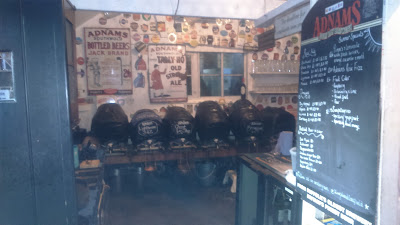Our local Wetherspoon’s outlet in Tonbridge, the Humphrey
Bean, has held a number of “tap-takeovers” during the past few years, where beers from the likes of Oakham, Sambrooks,
Rockin’ Robin and Thornbridge have been show-cased. Earlier this week it was the turn of Windsor & Eton Brewery. I was alerted
to this event via a message from a friend on WhatsApp, so after dinner I headed
down to the “Bean” to catch up with said friend plus another member of our
group, in order to check out what was on offer on the beer front.
I discovered four Windsor & Eton beers on sale, namely
Eton Boatman, Knight of the Garter, Conqueror and a beer brewed specially for
the Queen’s 90th birthday, called "90 Glorious Years". I started
with Knight of the Garter before moving on to “90 Glorious Years”. With one of
my regular check-ups at the Eye Clinic due the following morning, I thought I’d
better moderate my drinking, especially as I didn’t want to turn up all
“bleary-eyed”. I therefore stuck with just the two pints, enjoying the
opportunity to catch up with a couple of friends as much, if not more, than the
beer itself.
My friends, who had arrived before me, also gave the Eton
Boatman and the Conqueror a go. The former is a 4.2% Golden Ale, whilst the latter is a 5.0% “Black IPA”; a style which
is an oxymoron if ever there was one! My companions both liked it, saying it
was much smoother than a stout, without the harsh bitterness often associated
from the use of highly roasted malts. They also said it was pleasantly hoppy in
character; hardly surprising given the inclusion of Summit
and Cascade hops in the beer. Both agreed though, that one was enough.
I enjoyed my Knight of the Garter a 3.8% easy drinking Golden Ale, brewed with American Amarillo whole
leaf hops giving a distinctive fresh citrus aroma reminiscent of cut
grapefruit. “90 Glorious Years” wasn’t bad either; slightly darker in colour,
and that pleasant earthy hoppiness which can only come from English hops.
Being a Monday, the “Bean” was quite quiet, with even the Belgium
v Italy Euro 2016 game not providing sufficient attraction to pull in the
customers. For me though, it made a pleasant change to be out on a Monday
evening, and like I said it was good to catch up with friends; one of whom I
hadn’t seen for a couple of months.
Footnotes:
Windsor & Eton was formed by four friends who came together to bring brewing back to the heart of these two famous Berkshire towns. The brewery was launched on St Georges Day 2010; seventy-nine years after the closure of Windsor’s last brewery.
Windsor & Eton was formed by four friends who came together to bring brewing back to the heart of these two famous Berkshire towns. The brewery was launched on St Georges Day 2010; seventy-nine years after the closure of Windsor’s last brewery.
Since then, Windsor & Eton have gone from strength to
strength, offering a range of well-crafted and inspiring beers in cask, keg and
bottled form. The company now turns over £2.5 million and employs around 30
people. Major customers include M&S, the House of Commons, Ascot Racecourse
The Humphrey Bean
is Tonbridge's JD Wetherspoon outlet. Transformed into a pub from the town’s
former Crown Post Office, the "Bean" is not one of the company's
most imaginative conversions. The smaller section at the front is where the
post office counters once were, but the much larger section to the rear was
formerly the sorting office, and still maintains its shed-like appearance.
To be fair, it is bright and airy, with plenty of tables,
and includes a raised area on the left-hand side. This section leads through to
an attractive land well laid out garden, which looks out across the River
Medway to Tonbridge's imposing 13th Century castle.

























